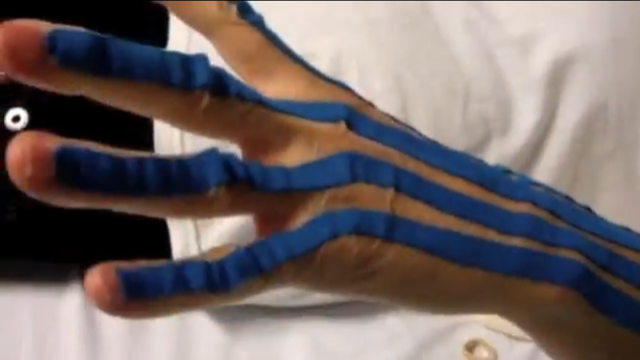In previous blog posts we have learned about Myofascial Release and Active Release Technique for stiffness and pain due to Parkinson’s. In this post I will talk about Kinesiology Taping to help your treatments last longer.

What is Kinesiology Tape?
Kinesiology Tape (Kinesio® Tape, Rock Tape, K Tape) has frequently been seen in recent years in competitive sports. Even in the Olympics you will see athletes with brightly colored tape all over their body.
This is different than athletic tape, which is a temporary brace to limit movement to support a joint. Kinesiology tape can facilitate your body’s somatosensory nervous system and circulatory system while providing support and stability to your muscles and joints, without restricting your body’s natural range of motion. Kinesiology tape is made up of cotton fibers with polymer elastic strands woven throughout. Whereas traditional athletic tape restricts blood flow and movement, kinesiology tape is pliable and allows for a full range of motion.

Applying this tape following your treatment can prolong the benefits of the therapy administered by your chiropractor or physical therapist beyond your time in the clinic. Depending on how it’s applied, kinesiology taping can help you engage a muscle more easily, or help create an environment that allows a muscle in spasm to relax. It may also help that terrible cramping in your feet.
Taping can also help alleviate pain and facilitate lymphatic drainage (to decrease swelling) by lifting the skin microscopically. This lifting effect allows for a decrease in inflammation of the affected areas by creating convolutions under the skin that allow your interstitial fluid to flow through more easily.
You can wear kinesiology tape without any movement disruption or constriction of the skin. When applied following your treatment session and in conjunction with corrective exercises, kinesiology tape can promote accelerated healing and higher activity performance. You can wear your tape for several days as it continues to deliver positive effects. The great news is that you can learn to apply it yourself. Make an appointment with a trained clinician and they can instruct you on how to properly apply kinesiology.
I encourage you to watch the video below to see Kinesiology Tape in action. You can see the stiffness in this woman’s hand caused by Parkinson’s and arthritis. Then you’ll be able to see how the tape helps wake up the signal to her hand and create greater ease of movement.
Resources:
http://running.competitor.com/2014/03/injury-prevention/tape-it-up-does-kinesiology-tape-really-work_51973
https://kinesiotaping.com
https://physioworks.com.au/Injuries-Conditions/Treatments/Kinesiology_Taping